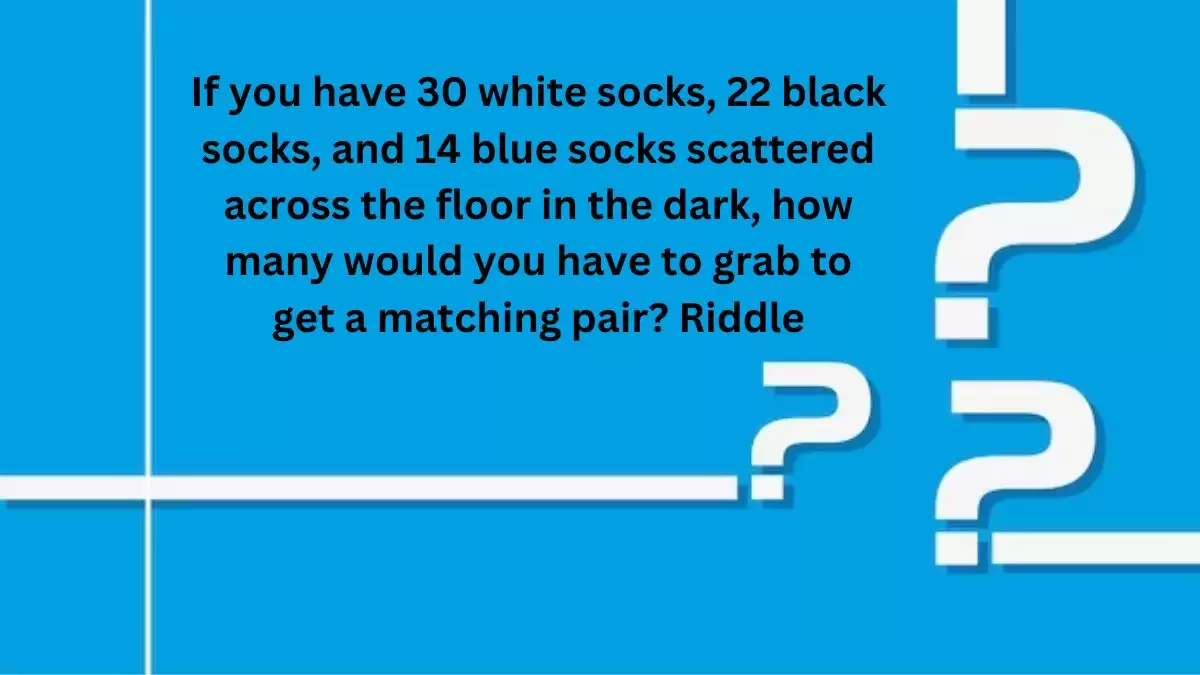If You Have 30 White Socks, 22 Black Socks, and 14 Blue Socks Scattered Across the Floor in the Dark, How Many Would You Have to Grab to Get a Matching Pair? Riddle and Answer
by Priyanka P
Updated Nov 04, 2023

If You Have 30 White Socks, 22 Black Socks, and 14 Blue Socks Scattered Across the Floor in the Dark, How Many Would You Have to Grab to Get a Matching Pair? Riddle
In the dark room with a jumble of white, black, and blue socks, you can employ a special method to discover how many sock grabs are needed to secure a pair without directly disclosing the answer. This technique relies on a smart approach to minimize the number of grabs. It revolves around the idea that not all the socks must be taken to find a matching pair.
Imagine each sock as having a unique color. To guarantee a match, you must consider the different colors available. With this in mind, you initially grab a sock of one color, then another sock of a different color. The key lies in understanding what happens next.
By avoiding the same color as the first two socks, you ensure that the sock you take on your fourth grab will undoubtedly match one of the previous two. This strategy allows you to find a matching pair in the fewest possible grabs.
Stay informed and up-to-date with the latest news and developments by turning to Fresherslive’s current news articles. Our platform is designed to help you broaden your horizons and gain valuable insights.
If You Have 30 White Socks, 22 Black Socks, and 14 Blue Socks Scattered Across the Floor in the Dark, How Many Would You Have to Grab to Get a Matching Pair? Riddle Explained
To solve this riddle, you need to apply a clever strategy. With 30 white socks, 22 black socks, and 14 blue socks, there are three different colors. The goal is to find a matching pair while grabbing as few socks as possible.
To achieve this, you start by grabbing one sock of each color – one white, one black, and one blue. This ensures you have three socks of different colors. No matter what sock you grab next, it will always match the color of one of the socks you already have because there are only three colors. Therefore, on your fourth sock grab, you are guaranteed to find a matching pair. You won't need to continue grabbing more socks after that point.
So, the answer is you would need to grab only four socks to get a matching pair in the dark. This strategy minimizes the number of sock grabs required to solve the riddle.
What is Riddle?
A riddle is a type of puzzle or word game that presents a mystery or question in a clever and often cryptic way. It typically involves a statement, question, or phrase with a hidden or double meaning, challenging the person to figure it out. Riddles come in various forms, such as enigmas, which require creative thinking and metaphorical interpretation, and conundra, which rely on wordplay or puns in the question or answer.
Riddles have been part of human culture for centuries and can be found in many different cultures worldwide. They are like brain teasers, designed to engage the mind and encourage problem-solving. People enjoy riddles for the mental challenge and the satisfaction of unraveling the hidden meaning. Riddles often serve as a form of entertainment and intellectual exercise, and they can be a fun way to test and expand one's thinking abilities.
Advantages of Solving Riddle
Solving riddles offers several advantages, making it an enjoyable and beneficial activity:
Mental Stimulation:
Riddles require critical thinking, creativity, and problem-solving skills. When you solve a riddle, you exercise your brain, keeping it active and sharp.
Enhanced Problem-Solving Skills:
Riddles often present complex challenges in a concise format. Solving them hones your ability to analyze information, think logically, and find innovative solutions.
Improved Language Skills:
Riddles play with words, encouraging better vocabulary, wordplay, and linguistic comprehension. They can be an enjoyable way to learn new words and phrases.
Boosted Confidence:
Successfully solving a challenging riddle can be incredibly satisfying, leading to increased self-confidence and a sense of accomplishment.
Entertainment:
Riddles are a source of entertainment and amusement, whether solved individually or as part of a group. They can be a fun way to pass the time.
Social Interaction:
Riddles often prompt discussions and interactions among people trying to solve them together, fostering teamwork and communication.
Cultural Understanding:
Riddles are found in many cultures, and solving riddles from different parts of the world can offer insights into diverse perspectives and traditions.
Creativity:
Riddles encourage thinking "outside the box" and inspire creative solutions to problems.
If You Have 30 White Socks, 22 Black Socks, and 14 Blue Socks Scattered Across the Floor in the Dark, How Many Would You Have to Grab to Get a Matching Pair? Riddle - FAQs
A riddle is a puzzling question or statement designed to test one's problem-solving skills, often with a hidden meaning.
Riddles are solved by carefully analyzing the question, considering double meanings or wordplay, and thinking creatively to find the answer.
Riddles are popular because they offer mental stimulation, boost problem-solving skills, and provide an entertaining challenge for individuals and groups.
Solving riddles enhances critical thinking, language skills, and self-confidence, while also promoting social interaction and cultural understanding.
The strategy to solve the sock riddle is to start by grabbing one sock of each color (white, black, and blue), ensuring that the fourth sock grabbed will be a matching pair.
Riddles are found in many cultures and provide insights into diverse perspectives and traditions, showcasing the universality of human curiosity and creativity.







